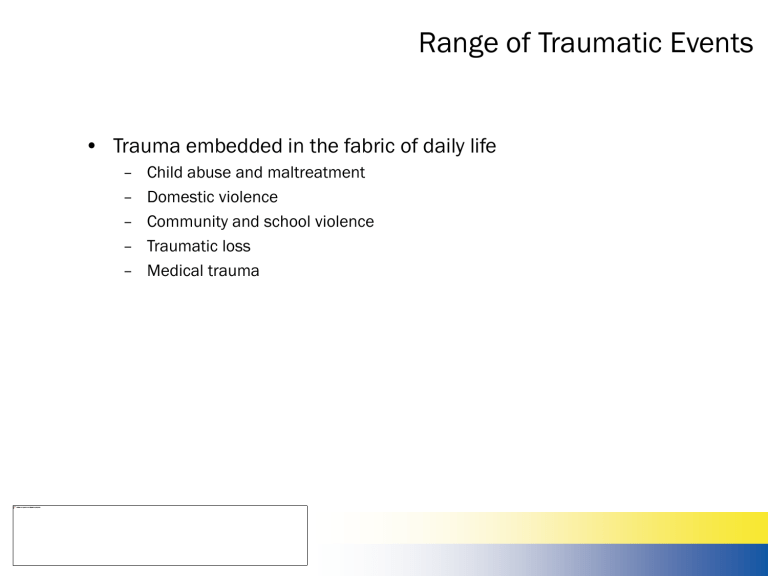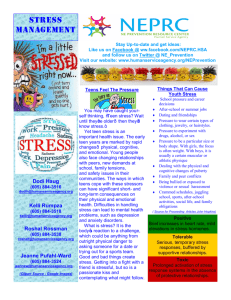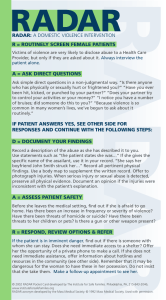Range of Traumatic Events

Range of Traumatic Events
• Trauma embedded in the fabric of daily life
– Child abuse and maltreatment
– Domestic violence
– Community and school violence
– Traumatic loss
– Medical trauma
• Humanitarian crises
– Natural and man-made disasters
• Earthquakes
• Floods, mudslides
• Hurricanes
• Tornadoes
• Volcanic eruptions
• Major transportation accidents
• Industrial accidents
• Technological disasters
– Catastrophes of human origin
• Armed conflicts/wars
• Genocide
• Terrorist attacks
Range of Traumatic Events
Physical Abuse
• Actual or attempted infliction of bodily pain and/or injury, including the use of severe corporal punishment.
• Characterized by physical injury (for example, bruises and fractures) resulting from punching, beating, kicking, burning, or otherwise harming a child.
• In some cases, the injury may result from over-discipline or physical punishment that is inappropriate to the child's age or condition.
• Physical abuse can occur in single or repeated episodes and can, in the extreme, result in death.
Psychological Maltreatment
• Includes acts or omissions by parents or caregivers that have caused, or could cause, serious behavioral, cognitive, emotional, or mental disorders.
• Examples include verbal abuse (e.g. insults, belittling, threats of violence), bullying and the use of coercive control, emotional neglect (e.g. shunning, withdrawal of love), and intentional social deprivation (e.g. isolation, confinement).
Neglect
• Involves the failure to provide needed, age-appropriate care although financially able to do so, or offered financial or other means to do so.
• Includes physical neglect (e.g. deprivation of food, clothing, shelter), medical neglect (e.g. failure to provide child with access to needed medical or mental health treatments or to consistently administer prescribed medications), and educational neglect (e.g. withholding child from school, failure to attend to special education needs).
Child Sexual Abuse
• Includes a wide range of sexual behaviors that take place between a child and an older person.
• Behaviors that are sexually abusive often involve bodily contact, such as in the case of sexual kissing, touching, fondling of genitals, and intercourse.
• However, behaviors may be sexually abusive even if they do not involve contact, such as in the case of genital exposure
("flashing"), verbal pressure for sex, and sexual exploitation for purposes of prostitution or pornography.
Domestic Violence
• Sometimes referred to as intimate partner violence, domestic abuse, or battering.
• Includes actual or threatened physical or sexual violence or psychological and emotional abuse between adults in a child’s home environment.
• Domestic violence can be directed toward a current or former spouse or relationship partner, including heterosexual or samesex partners.
Community Violence
• Refers to both predatory violence (e.g. robbery) and violence arising from non-family interpersonal conflicts.
• May include brutal acts such as shootings, rapes, stabbings, and beatings.
• Children’s exposure to community violence can be as direct victims or as witnesses (e.g. seeing someone killed, hearing gunfire).
School Violence
• Indicators of school violence include fatal and nonfatal student victimization, nonfatal teacher victimization, students being threatened or injured with a weapon at school, fights at school, and students carrying weapons to school.
• Formal definitions of school violence range from very narrow to very broad, and could include "any behavior that violates a school's educational mission or climate of respect or jeopardizes the intent of the school to be free of aggression against persons or property, drugs, weapons, disruptions, and disorder."
Traumatic Loss
• Childhood traumatic grief occurs following the death of a loved one when the child objectively or subjectively perceives the experience as traumatic.
• The cause of death can be due to what is usually described as traumatic, such as an act of violence, accident, disaster, or war, or it can be due to natural causes.
• The hallmark of childhood traumatic grief is that trauma symptoms interfere with the child’s ability to navigate the typical bereavement process.
Medical Trauma
• Includes trauma associated with an injury or accident, chronic or life-threatening illness, or painful or invasive medical procedures.
• Examples include the event of being told that one has a serious illness (e.g. cancer or AIDS) and the experience of medical procedures such as changing burn dressings or undergoing chemotherapy.
Refugee Trauma
• Refugee trauma includes exposure to war, political violence or torture.
• Refugee trauma can be the result of living in a region affected by bombing, shooting, or looting, as well as forced displacement to a new home due to political reasons.
• Some young refugees have served as soldiers, guerrillas or other combatants in their home countries, and their traumatic experiences may closely resemble those of combat veterans.
Disaster
• Any natural catastrophe (e.g. tornado, hurricane, earthquake)
• Regardless of cause, any fire, flood, or explosion that causes damage of sufficient severity and magnitude to warrant the intervention of local, state, or federal agencies and disaster relief organizations.
• Disasters can be the unintentional result of a manmade event
(e.g. nuclear reactor explosion).
Terrorism
• Terrorism is defined in a variety of formal, legal ways but the essential element is the intent to inflict psychological damage on an adversary.
• The U.S. Department of Defense defines terrorism as "the calculated use of violence or the threat of violence to inculcate fear, intended to coerce or to intimidate governments or societies in the pursuit of goals that are generally political, religious, or ideological."
• Terrorism includes attacks by individuals acting in isolation (e.g. sniper attacks).







